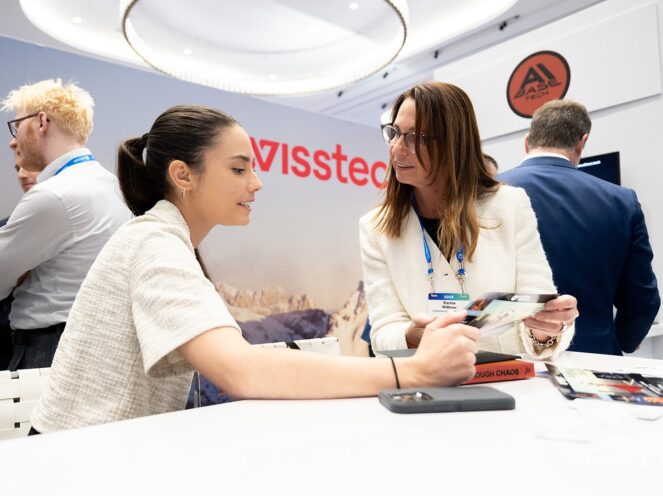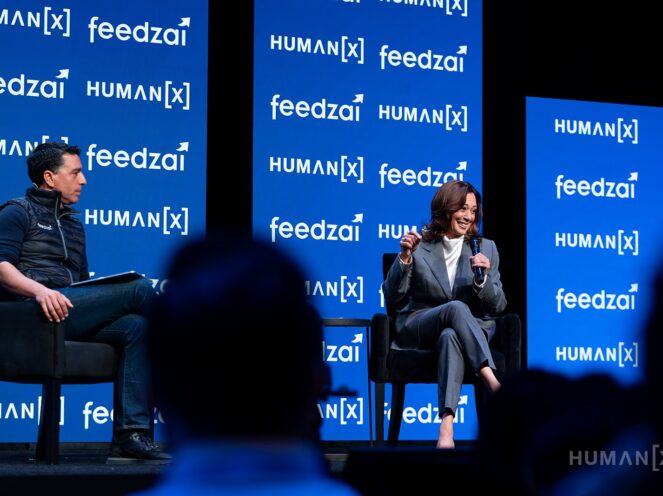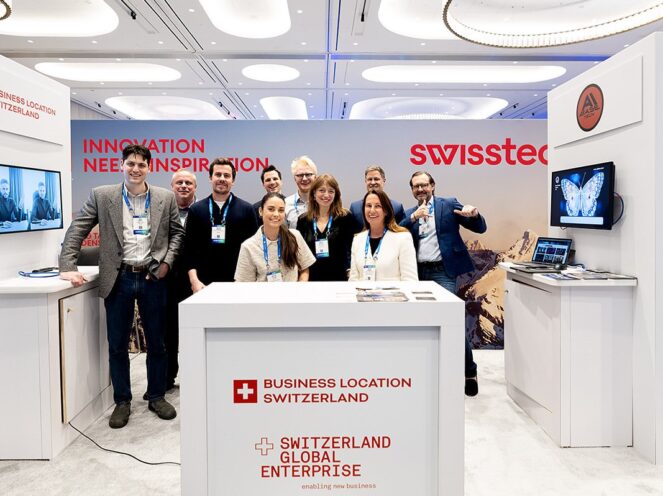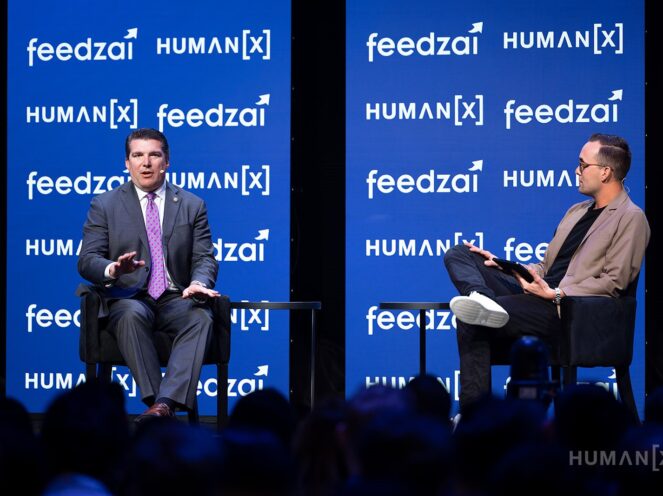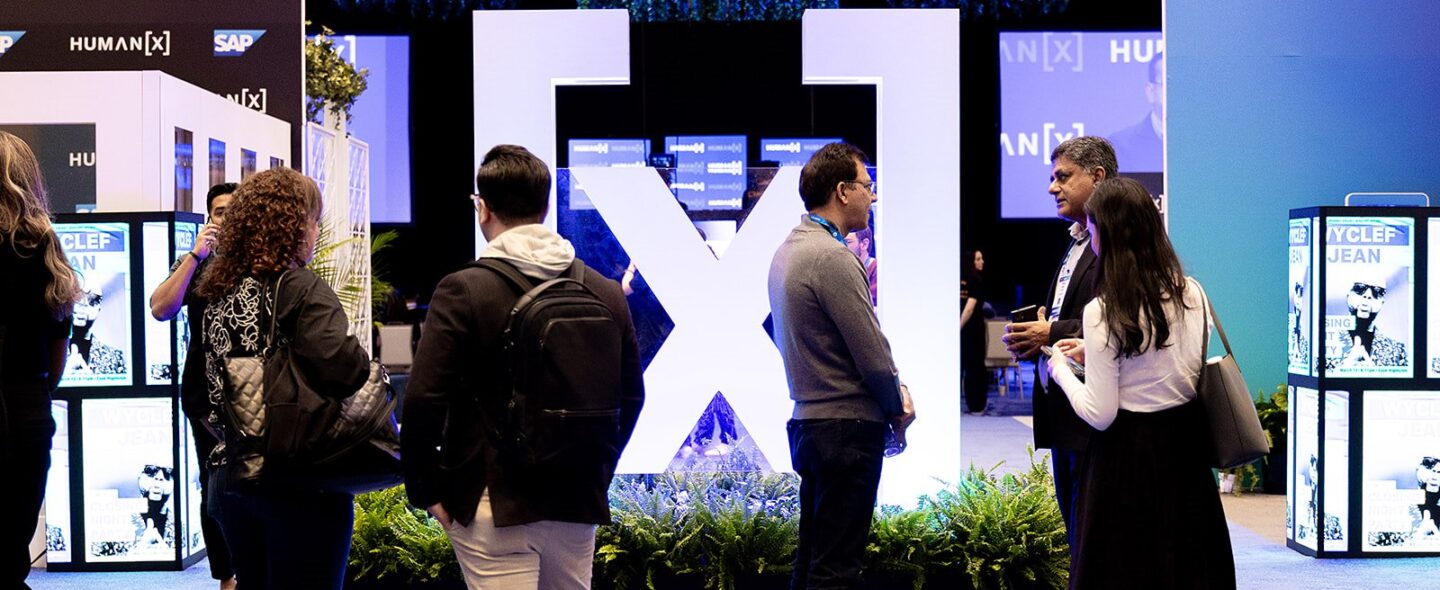
San Francisco – March 24, 2025
From March 10 to 13, Swissnex San Francisco, in collaboration with Presence Switzerland, Swiss Business Hub USA, Business Location Switzerland, and Switzerland Global Enterprise (SGE), hosted a SwissTech pavilion at HumanX, the first edition of the AI-focused conference held at the iconic Fontainebleau Hotel in Las Vegas. The event gathered over 3,000 attendees from around the globe and featured more than 350 expert speakers, including Kevin Weil, Chief Product Officer at OpenAI; Mike Krieger, Chief Product Officer at Anthropic; Thomas Wolf, Co-founder and at Hugging Face; and Arthur Mensch, Co-founder and CEO at Mistral AI. To represent Swiss innovation at HumanX, three startups, Neoinstinct, Egonym, and Aibase.tech, showcased their technologies and developments in artificial intelligence at the Swisstech pavilion.
Additionally, during the conference, the Swiss team hosted a luncheon with AI leaders on why Switzerland is the place to be and why companies like OpenAI and Anthropic recently opened up Swiss offices. The answer: access to top talent and research through renowned academic institutions, tech-friendly regulations, and fertile ground for innovation.
While the conference explored AI applications across a wide variety of fields, this article will focus on three highly relevant themes to Switzerland’s economy: finance, cybersecurity, and healthcare.
AI and Finance:
AI Investment and Market Disruption:
- Josh Constine from SignalFire shared that there has been an unprecedented flow of capital into AI startups since the gen-AI boom, “There’s been $30 billion invested this quarter alone and $50 billion more in the works. And that is turning venture capital upside down” signaling massive economic opportunities but also intense competition and market disruptions.
- No need to spot the next Open AI. Steve Jang, managing partner at Kindred Ventures, rightfully spotted two important facts: first, distillation and open source models: companies can bypass extensive early-stage training by distilling and fine-tuning existing open-source models (e.g., DeepSeek). This approach significantly reduces time and costs, making quicker market entry without massive infrastructure spending. Second, enterprise readiness requires more than big models. A powerful model alone isn’t sufficient for enterprise adoption; enterprises demand robust software infrastructure.
Automation as a Key Economic Driver:
- Marc Bhargava from General Catalyst emphasized a striking statistic: “In the next five years, there will be about $15 trillion worth of economic output coming from AI,” continuing on the immense scale of automation (30-70%) possible across sectors like accounting, legal, and customer support. As AI systems become more sophisticated, businesses are beginning to reimagine entire processes and are trying to integrate automation at different stages. The buzz around AI agents is accentuating these trends.
AI Transforming Investment Strategies:
- AI-driven tools are reshaping portfolio management by automating tedious analytical tasks. Gabriel Banks, Founder and CEO, QuillAI highlighted that traditional finance involves “70% of Excel monkey work,” which AI can automate, freeing professionals to focus on higher-value tasks such as investment decision-making.
- Michelle Heppler, Co-Founder & CCO of Swiss Startup Unique was present with a booth at the conference to promote their platform that empowers financial services by using AI such as customizable agents to significantly enhance efficiency across research, compliance, and KYC. Their impressive client base already includes Julius Bär, PostFinance, and Pictet.
While the tone was overall optimistic, leaders across panels and also during discussions advised caution. For instance, areas such as customer application, Prem Natarajan from Capital One spoke about deploying generative AI carefully in customer interactions with their tool “ChatConcierge”, and pointed out the crucial importance of a “human-in-the-loop” approach to guaranteeing consumer trust.
AI and Cybersecurity:
Experts made the point of AI as a “double-edged sword,” as it is a powerful tool both for cyber attackers and defenders. It seems that cybersecurity is slowly entering a new era defined by what experts describe as “AI versus AI.” The accessibility of the technology has lowered the barrier for criminals, and cyber criminals are increasingly using generative AI to launch sophisticated attacks that can bypass traditional security measures.
AI and New Threats:
- Vijay Balasubramaniyan, CEO & Co-founder at Pindrop Security, underscored the rapid escalation in AI-powered cybercrime: “Just last year, cyber-attacks jumped 800%. From one attack per month to one per day and per customer, with some financial institutions facing attacks every three hours”.
- Charles Carmakal, CTO of Mandiant, highlighted a shift toward social engineering threats, stating that criminals use AI primarily for “disinformation and misinformation,” leveraging realistic synthetic voices or even Zoom video deepfakes to execute scams like fraudulent invoice payments.
AI for Threat Detection and Response:
- AI has significantly improved the efficiency of threat detection, automating many tasks that were traditionally labor-intensive. Amazon’s Chief Security Officer Steve Schmidt explained how the company developed some AI tooling to leverage existing threat intelligence tools like ” MadPot ,” a honeypot network that identifies threats rapidly at scale, significantly reducing the response time of security teams. Additionally, Amazon has launched “ Amazon Nova Trusted AI Challenge”, an annual university competition focusing on advancing the capabilities of LLMs for software development, exploring new techniques to automatically identify possible vulnerabilities and effectively secure these models.
- Cybersecurity professionals, such as Galina Antova from Claroty, mentioned that the velocity, automation level, and sheer volume of AI-powered attacks require defenders to embrace AI to keep pace as manual approaches become increasingly unsustainable. “With AI, I think we will finally have fully staffed cybersecurity teams and, therefore, have a chance to fight AI with AI because AI doesn’t sleep.”
- To experience this first hand, there was a fantastic game at the booth of feedzai, a data science company that develops real-time machine learning tools to identify fraudulent payment transactions. They installed a game where people could measure themselves next to their AI system in order to identify fraud in various emails and text messages. While our AI program Manager, Maulde Cuérel, caught most issues that would flag the message, it took her a total of over 5 minutes to identify all of them, while it took the AI only a few seconds
Similarly to finance, experts seem to unanimously agree that while AI can automate extensive parts of cybersecurity operations, it is important to maintain “humans in the loop” to oversee decision-making and maintain trust. “Right now, agents are not accurate enough to take autonomous action in most cases, but we’ve ended up significantly improving the lives of the security engineers, allowing them to be more efficient at what they have to do, and let’s face it, who has enough security professionals on their staff? ” Steve Schmidt, Chief Security Officer, Amazon.
AI and Healthcare:
Precision Medicine and Personalized Treatment:
- Precision medicine emerged as a major AI trend, with experts highlighting how AI can significantly reduce the traditional trial-and-error approach in treatment. Elliot Green from Dandelion Health emphasized AI’s ability to match treatments to patients more precisely, improving outcomes by ensuring patients receive the right treatment from the start.
- AI’s ability to match precise treatments to individual patients (“precision medicine”) was repeatedly spotlighted. Jean-Frederic Petit-Nivard from Owkin, who had their first tool regulatory cleared in Europe in 2021 using AI for tissues, highlighted the complexity but great potential of AI in healthcare, explaining that “AI helps clinicians identify exactly which patients will respond to which treatments, bringing clarity and efficiency to personalized medicine”.
Reduce Administrative Burden:
- Physician burnout is a serious crisis, with clinicians spending nearly 50% of their time on administrative tasks. AI solutions, like Suki AI, present at the conference, tackle these challenges by reducing documentation burdens, allowing clinicians more time for direct patient care.
- Anika Gartenhier from Ardent Health Systems stated that “clinician burnout and workforce shortages are the two biggest problems healthcare faces today,” emphasizing that AI is essential for improving efficiency and patient experience through smarter workflow management and operational efficiency.
Drug Discovery:
- AI is accelerating drug discovery by optimizing the identification and testing of therapeutic molecules. Alex Zhavoronkov, CEO of Insilico, highlighted, “The greatest opportunities that I see in AI drug discovery are aging. Now, massive AI models, transformers, and diffusion models allow you to build what I call “life models,” trying to understand life from the cradle to the grave in healthy people, and then look at the breaking points where aging becomes a disease.”
- Nathan Higginson-Scott from Seismic Therapeutic echoed this optimism, noting that AI’s integration in biotechnology drastically cuts down traditional timelines: “With machine learning, we’re able to turn promising molecules into viable drug candidates faster, more efficiently, and with fewer design and test cycles.”
As discussed, AI’s immediate practical impacts include reducing administrative burdens, improving resources, delivering better healthcare, and speeding up drug development processes. Yet despite widespread enthusiasm, speakers remained realistic about AI’s limits. Most experts point out that adoption remains cautious, as in healthcare, trust and transparency must precede widespread AI adoption. Concerns around privacy, regulation, and ethical considerations were frequently debated as well, highlighting the careful balance required between innovation and accountability.
This was just a glimpse of what happened at Human X 2025. If you are interested in taking part in the 2026 edition, note that it will take place in San Francisco in April 2026!
If you would like to learn more about the AI ecosystem in the Bay Area, whether it’s for your startup, company, creative project, or scientific research, we invite you to follow our activities and reach out to Maulde Cuérel, AI Program Manager at Swissnex in San Francisco.
Written by Maulde Cuérel, AI Program Manager at Swissnex in San Francisco. Maulde is committed to connecting Switzerland and the Bay Area in AI. Her main objective is to ensure that we are active in the future of AI and that Switzerland continues to be a key player in this sector.
Edited by Gwenaëlle Gisiger, Communications Associate at Swissnex in San Francisco
